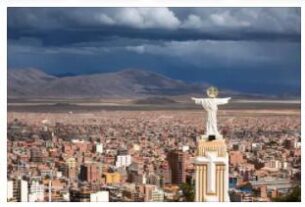CULTURE: TRADITIONS
In Bolivia, ethnic groups of different origins and cultures coexist, which preserve very different traditions; the national framework was then considerably enriched following the introduction of Spanish traditions. The preeminent folkloric aspect, however, is given by the Indians. Indian spirit and Catholic-Spanish culture coexist in syncretic forms, blending animism and Catholic faith, evolved rites and witchcraft. The magic is still in vogue, and also appears in the patron saints festivities. The Indians pay particular attention to these solemnities, which essentially center on dance (strong forms of emulation between country and country). The most ancient dances, performed to the sound of the cane whistle (quena), or the syringe of Pan (sicus), date back to pre-Inca times. Many dances are nothing but pantomimes (like the mallcu), reproducing hunting scenes and fights between animals or facts of the Spanish conquest. Very popular dance is the quena-quena, danced by men and influenced by the customs of the people of the Amazon. Among the most popular festivals it is worth mentioning that of San Pedro, on the Titicaca, of pagan origin and connected to the life of fishermen (the use is in common with the Peruvian people). Typical of the people devoted to agriculture is the festival of Pacha-Mama ; expression of the people dedicated to mining is instead the festival called Diablada(the idea of the devil, an underground divinity, and of life in the mine are connected to it), celebrated with the use of demonic masks. The women’s costumes are very varied, which differ from area to area for the colors (typical of the La Paz area is the use by women of a bowler hat); the Andean costumes are less gaudy, the costumes of the mestizo women are more lively. Simple is men’s clothing; the Indians use a typical wool balaclava in various colors. The handicraft activity, practiced mainly by women, is essentially based on weaving. The power supply is very poor; national dishes are mote (boiled corn kernels) and mani (peanut sauce with a lot of pepper). Widespread is the chicha (obtained from the fermentation of maize grains), a real scourge of the Andean people.
CULTURE: LITERATURE
There were few local contributions to colonial literature: a modest rhymer named Juan Sobrino (17th century) and the most gifted chronicler Bartolomé Martínez y Vela, author of the pleasant Anales de la Villa Imperial de Potosí (18th century), were the only writers of any relief. In the rich Potosí there were also theatrical performances, but not much is known about them. The Jesuits had a small printing house in Juli, in which a valuable Aymará dictionary by Father Bertonio was printed in 1705; but only after independence (1825) did the press really work and the first newspaper appeared: El Telégrafo(1822). Even after the birth of Bolivia, a country located in South America according to topb2bwebsites, however, the country’s isolation and the lack of important cultural centers made literary developments slow and uncertain. “Revolutionary” writers were Vicente Pazos Kanki, author of Memorias histórico-políticas (1834), and Casimiro Olañeta (1796-1860), orator and publicist. Bolívar’s polygrapher and biographer was José M. Loza (1799-1862). The romance brought a number of versifiers: Ricardo J. Bustamante, María J. Mujia poet (1820-88), Néstor Galindo (1830-65), author of Lágrimas(1856), shot by the tyrant Melgarejo, and some others; while a second and late romanticism is represented by the prolific Adela Zamudio (1854-1928) and Isaac G. Eduardo (1861-1924). Of greater importance is Nataniel Aguirre (1842-88), poet, storyteller (Juan de la Rosa, 1885) and playwright (Visionarios y mártires, 1865); and a certain personality Félix Reyes Ortiz (1828-83), poet and playwright. Numerous historians and critics, including Gabriel R. Moreno (1834-1908). The “modernist” poetic renewal had a notable standard in Ricardo Jaimes Freyre (1868-1933), who lived almost always in Argentina (Castalia bárbara, 1897; Los sueños son vida, 1917); and other notable representatives such as Manuel M. Pinto (1871-1940), Gregorio Reynolds (1882-1941) and especially Franz Tamayo (1880-1956), a valued poet and essayist. Among the narrators, the first place belongs to Alcides Arguedas (1879-1946), who gave in Raza de bronce(1919) one of the masterpieces of indigenist fiction; other aspects of the Bolivian reality were interpreted by Armando Chirveches (1883-1926), Jaime Mendoza (1874-1940), known as the “Bolivian Gorkij”, A. Alarcón, GA Navarro, JF Bedregal, etc. Critic and poet was R. Villalobos (1860-1939). In the twentieth century panorama, modest due to the difficult situation in the country and the low cultural level of the population, the following stand out among the poets: Octavio Campero, Yolanda Bedregal (1926-99), Jorge Suárez, Félix Rospigliosi and especially Pedro Shimose (b.1940), who is also a wide-ranging narrator, publicist and critic, musicologist and designer; among the narrators: Augusto Céspedes (1904-97), forerunner of South American magical realism (Sangre de mestizos, El diputado mudo); Oscar Cerruto (1912-81), not only novelist, but poet, journalist and diplomat, he is remembered Cerco de penumbras (1958) and the collection of verses Cántico traspasado (1975); Augusto Guzmán, (1903-94), literary critic and appreciated historian, was awarded in 1961 with the Premio Nacional de Literatura ; his most famous work is Prisionero de guerra (1937) on his own experience in the Chaco war; Raúl Botelho Gosálvez (1917-2004); among the essayists: Fernando Díez de Medina (1908-90), one of the most authoritative pens of the Bolivian press and also the author of works of fiction and poetry, and Jesús Lara (1898-1998), a literary voice whose production was almost entirely dedicated to the cause of the Indians (Popular Quechua Poetry, 1956; Inkallajta-Inkaraqay, 1967; Mitos y Leyendas y Cuentos de los Quechuas, 1973). In the years around the turn of the millennium, new names were added, such as Ramon Rocha (b. 1950), author of Pedagogia de la Liberacion (1975), El Run Run de la Calavera (1983), Ladies Night (2000); Ce Mendizabal (b. 1956), who divides his business between stories, poems and journalistic articles; Victor Montoya (b.1958), who passed through exile in Sweden (Días y noches de angustia). The theme of the homeland, the harsh socio-economic conditions and a different future remain, however, the main topics of Bolivian literature.




